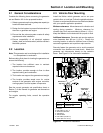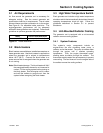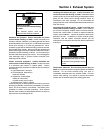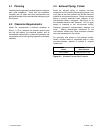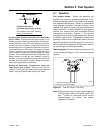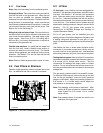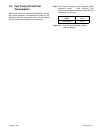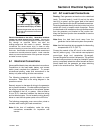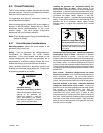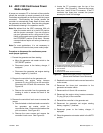
TP-6335 9/0410 Fuel System
5.1.1 Fuel Lines
Note: Keep fuel lines away from the exhaust system.
Routing fuel lines. Take carewhen routing the fuel line
from the fuel tank to the generator set. Keep the fuel
lines as short as possible but maintain adequate
clearance from the exhaust system. Route the fuellines
along the frame or undercarriage—never route the fuel
lines inside the habitable area of the vehicle. Locate the
fuel lines with the entry point near the fuel pump. See
Section 5.4 for the fuel pump lift.
Sizing fuel inlet and return lines. Size the fuel line to
handle the flow of fuel and to withstand road shock and
year-round climate conditions. Use steel tubing as the
codes require. Use 8 mm (0.31 in.) ID tubing with a
230 mm (8 in.) (minimum) flexible section to allow free
movement of the generator set.
Flexible hose sections. If a metal fuel line draws fuel
from the fuel tank, install a flexible hose section to
connect the metal line to the fuel pump. The flexible
section allows generator set vibrational motion during
operation. See Section 7 for the fuel inlet and the fuel
return connection points.
Note: Gasoline-fueled engines require a type A1 hose.
5.2 Fuel Filters or Strainers
Gasoline model generator sets are shipped with a fuel
filter. No additional fuel filter or strainer is required.
1
ADV-6450-E
1. Fuel filter
Figure 5-2 Fuel Filter Location (Gasoline Models)
5.3 LP Gas
LP fuel hose. Use a flexible fuel hose designated for
use with LP fuel betweenthe generator set andthe main
fuel tank. See Section 7 for the fuel inlet connection
point. Take care when routing the fuel line. Maintain a
51 mm (2 in. ) clearance between the fuel line and any
bareexhaust component. Do not tie any electrical wiring
to the fuel line. If the flexible fuel line passes through
sheet metal, install grommets or clamps to prevent hose
abrasion. The LP fuel system shall conform to
Section 3-6.4 of NFPA58, Storage and Handling of
Liquified Petroleum Gases.
For an LP gas system, use UL classified pipe joint
sealing compound to prevent dangerous fuelleaks. Use
a sealing compound approved for use with LP gas.
ApplyUL classifiedsealing compound at all fuel linepipe
joints.
Use flexible fuel lines in areas where vibration and/or
movement of connected components is likely, such as
the main fuel line to the generator set. Use seamless
steel tubing wherever long main fuel lines are required.
Testing the fuel system. After all of the LP connections
have been completed, pressuretest the entiresystem to
6--8 ounces (10--14 inches) water column. Test the
connections for leakage with soapy water or bubble
solution. Do not use solutions that contain ammonia or
chlorine since the solutionwill not bubble for anaccurate
leakage test.
The gas supply pressure should not exceed 6 ounces.
To check the inlet pressure, remove the plug on the fuel
inlet for the gas regulator. Insert an ounce pressure
gauge or manometer. Adjust the operating pressure to
4--6 ounces or 7--11 inches water column; adjust the
inlet pressure on the primary regulator.
Note: Fuel leakage could cause an explosion. After
making all LP gas connections, pressure test the
entire system to 6--8 ounces (10--14 inches)
water column.
Note: Gas pressure above 10 ounces can result in non
operation of the gas valve.




